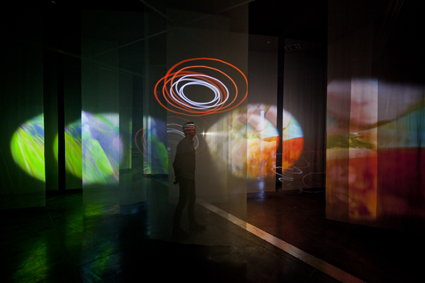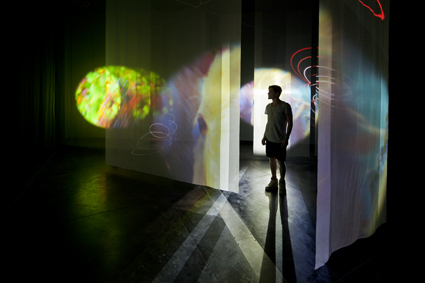video art & the uncontainable imagination
urszula dawkins: pipilotti rist, i packed the postcard in my suitcase

Pipilotti Rist: I Packed the Postcard in My Suitcase, 2011
photo Andrew Curtis
Pipilotti Rist: I Packed the Postcard in My Suitcase, 2011
IN THE LARGE CENTRE ROOM AT ACCA, ENORMOUS AMOEBIC BLUE BLOBS ARE CAREFULLY PAINTED ONTO AVOCADO WALLS, THEIR RANDOM BUT FAMILIAR SHAPES REPEATED ON TWO LARGE SCREENS WHICH FACE DIRECTLY DOWN FROM THE CEILING. VISITORS TO THE GALLERY ARE PASSIVELY DIRECTED TO LIE DOWN AND LOOK UP, SPRAWLED OVER THE HUMAN-SHAPED BLOBS CREATED BY ISLANDS OF TIERED CARPET, EACH SUCCESSIVE LAYER SMALLER THAN THE LAST SO THAT THE WHOLE SEEMS LIKE A SERIES OF TOPOGRAPHIC LINES.
It’s an elaborate and carefully constructed decor, reminiscent of some 70s pleasure-pad, the random shapes and textured pile evoking psychedelic dreams. But the ‘art’ is on the screens above: from below we look up at a video which looks down from above, the camera stalking a woman as she walks, climbs trees, drops her bundle of small red balls—are they fruit, are they artifice? The colour is lush, almost unreal, and things keep changing. Surfaces break and swim under swathes of hair or kelp. We surrender, passive and pacified, to an endlessly morphing series of images, elements and colours, as mesmerising and as mutable as the Northern Lights, and in many ways as inscrutable.
Gravity Be My Friend (2007) is one of several works in I Packed the Postcard in My Suitcase, the first major Australian survey of Swiss artist Pipilotti Rist’s work. The opening line of Juliana Engberg’s catalogue essay sums up the almost naïve flavour that infuses Rist’s work: “Welcome to the wonderful worlds of Pipilotti Rist.” Engberg describes “fantasy worlds born of the poetic psyche” which are “gorgeous and generous,” “ecstatic,” and “restorative.” In other words, Rist’s is a world where pleasure is privileged: while the technology and Rist’s virtuosic video composition are crucial, the purpose seems ultimately to be revelry ahead of revelation.
Rist herself speaks of “freeing the image,” “mixing it with your body, with the rooms.” Describing the gallery as “a collective living room where people meet,” she creates in it “a manual for the people to do it themselves.” “I hope,” she says, “[that] people will go home and put their flat screens on the ceiling.”
There’s an unfamiliar and perhaps refreshing artlessness in the statement. More familiar and perhaps more satisfying than the admittedly joyous hallucinations of Gravity Be My Friend are the two works first seen on entering the exhibition: one, a framed painting of a tourist view of Venice, overlaid with video; the other the polished surface of a dining table on which rich projections play.

Pipilotti Rist: I Packed the Postcard in My Suitcase, 2011
photo Andrew Curtis
Pipilotti Rist: I Packed the Postcard in My Suitcase, 2011
Small Laguna (2011) begins with the taken-for-granted ‘frozen’ memory of a place—a framed oil painting of Venice—and overlays it with Rist’s eternally fluid images and colours. A cluster of cherry blossom competes with a raw red sausage; a naked, dancing woman in what seems a stark hospital room gives way to tunnels of mysterious fibre, or lush, veined lips, or wisps of smoke. The images are applied to the ‘canvas’ with the precision of a brush—it’s as though Rist determines to take the trope of a flattened and singular memory and confound it with myriad ‘real’ memories: the constant stream of visual images experienced by everyone, all the time, whose viscerality and plenitude are erased by default in every representation we manage to make.
At the dining table, with its sparse setting of dishes and wine glasses, the moving pool of light morphs from kaleidoscopic patterns to birthday candles to what seem like petals of blue gas flame. Under dim ambient light there’s a sense of the table itself beginning to move and play also; the colours catch in the glasses and seem to animate them. Upside Down Table (2011) is unsettling: a familiar domestic setting, but one where the lush play of mind-images points to a rift between the imaginative and the grounded. Rather than immersing the viewer, it shines uncanny light on the limits of freedom to a soundtrack that seems to echo conversations, muzak and the objects that form the video’s constant play.
If the sequence of the exhibition leads initially from an uncanny overlap of material and immaterial to the supine and sublime immersion of Gravity…, the immersion is completed in the third room, where drifts of voile fabric capture vignettes of pastoral scenes, graphics like smoke rings and curious breezes. Free to wander in the midst of Rist’s visuals, the visitor is, theoretically, completely within the saturated mindscape of Administrating Eternity (2011); at the same time, the tactility and the necessity to return to the body, to walk, to touch, are preparation for the final room in Rist’s series of spaces.
Entitled I Couldn’t Agree with You More (1999), this last room zooms both in and out, strangely stark: one wall of the space is taken up by a screen on which a woman walks around a supermarket, the camera solipsistically turned on herself and the shelves disorientingly slipping by, filled with products to replace the now-expected cornucopia of luscious and colourful images. Superimposed on the woman’s forehead is a vignetted film in miniature—a series of men and women, like forest-creatures, who seem to enact a clumsy, primal love-chase around her mind. Created well before the other works in the exhibition, this piece seems a seed: a suggestion of the stories within stories formed by the interplay of memory, imagination and banal reality which balloon to ecstatic proportions in the more recent work.
Unlike much contemporary video work, I Packed the Postcard in My Suitcase seems for the most part to sidestep interpretation and intellectuality in favour of unapologetic hedonism. I’m reminded of Linda Dement’s statement that her aim is “to give form to the unbearable.” Pipilotti Rist’s work seems to take an opposing but complementary trajectory, intent on going beyond words to a poetic realm and giving deliberate form to the pleasurable. But it is the slightly unsettling works—the almost-trembling dining table and the weird interior/exterior of the supermarket scene—that have deepest resonance. There is a sense that these are the places where we are allowed to think rather than simply feel. Not captive in the television-like, psychedelic lure of Gravity Be My Friend, the real wonder in these first and last seen works lies in the fragments we cannot quite absorb and must participate in to apprehend; and their suggestion both that imagination is uncontainable and that it inevitably affects and changes what’s around it.
Pipilotti Rist, I Packed the Postcard in My Suitcase, Australian Centre for Contemporary Art (ACCA), Melbourne, Dec 21, 2011-March 4, 2012
RealTime issue #108 April-May 2012 pg. 45






